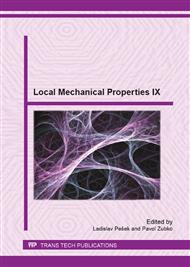p.120
p.125
p.129
p.133
p.137
p.141
p.146
p.150
p.154
Microstructural and Vickers Microhardness Evolution of Heat Treated Secondary Aluminium Cast Alloy
Abstract:
Secondary aluminium alloys are made out of aluminium scrap and aluminium-processable waste by recycling. These alloys contain different alloying elements such as Al, Cu, Fe, Si and Mg that form intermetallic phases in aluminium matrix and influence on the microstructure, basic mechanical properties and microhardness evolution in aluminium cast alloy. As experimental material was used secondary aluminium cast alloy AlSi9Cu3. Material was subjected to heat treatment (age-hardening) consisting of a solution treatment at temperature 515 °C with holding time 4 hours, than water quenching at 40 °C and artificial aging by different temperature 130 °C, 150 °C and 170 °C with different holding time (2, 4, 8, 16 and 32 hours). The age-hardening led to changes in the morphology of structural components, but also leads to precipitation of finer hardening phases in the material substructure. As optimal age-hardening mode for secondary aluminium cast alloy AlSi9Cu3 was determined mode consisting of solution treatment at temperature 515 °C with holding time 4 hours and artificial aging at temperature 170 °C with holding time 16 hours. After this heat treatment cast alloy shows the best changes in microstructure and mechanical properties. These changes are comparable with changes by primary AlSi9Cu3 cast alloy.
Info:
Periodical:
Pages:
137-140
Citation:
Online since:
September 2013
Authors:
Price:
Сopyright:
© 2014 Trans Tech Publications Ltd. All Rights Reserved
Share:
Citation:


